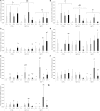Dietary Methionine Improves the European Seabass (Dicentrarchus labrax) Immune Status, Inflammatory Response, and Disease Resistance
- PMID: 30524433
- PMCID: PMC6256742
- DOI: 10.3389/fimmu.2018.02672
Dietary Methionine Improves the European Seabass (Dicentrarchus labrax) Immune Status, Inflammatory Response, and Disease Resistance
Abstract
Methionine presents a pivotal role in the regulation of many cellular events with crucial impact on the immune system, such as in processes involved in the control of inflammation and polyamines synthesis. Accordingly, the present study aimed to assess the modulatory effects of dietary methionine on the European seabass (Dicentrarchus labrax) immune status, inflammatory response and disease resistance to Photobacterium damselae subsp. piscicida (Phdp). For this purpose, fish were randomly distributed in three independent groups (three replicates per group) and each was fed the corresponding diet: a control diet (CTRL) formulated to meet the established amino acid requirements for the species; a diet supplemented with methionine at 0.5% of feed weight relative to the CTRL diet (8.2% of methionine concentration above CTRL); and one supplemented with methionine at 1% of feed weight to the CTRL diet (11.8% of methionine concentration above CTRL). To evaluate the immune status of fish fed with each of the diets before being submitted to bacterial infection fish were sampled from each group at 2 and 4 weeks after the beginning of feeding. Non-sampled fish were injected intraperitoneally with Phdp (5 × 103 cfu/fish) at 4 weeks after initiation of feeding and the inflammatory response (at 4, 24, and 48 h post-infection) and survival (lasting 21 days post-infection) evaluated. Fish hematological profile, peripheral cell dynamics, plasma humoral immune parameters, leucocyte migration to the inflammatory focus and head-kidney gene expression were evaluated. Results show that methionine dietary supplementation improves seabass cellular immune status without evidence of activation of pro-inflammatory mechanisms. Additionally, the observed enhanced immune status provided by methionine supplementation translated into an improved immune response to infection, as higher cellular differentiation/proliferation and recruitment to the inflammatory focus, improved plasma humoral immune parameters and modulation of key immune-related genes was observed. Lastly, after a bacterial challenge, higher survival was observed in fish fed supplemented diets, ultimately corroborating the positive effect of methionine administration for 4 weeks in the cellular immune status.
Keywords: amino acids; cell proliferation; fish; immunostimulation; inflammation; nutraceutics.
Figures



 ), MET 0.5 (
), MET 0.5 ( ) and MET 1 (
) and MET 1 ( ) dietary treatments for 4 weeks and subsequently infected with Phdp (n = 60).
) dietary treatments for 4 weeks and subsequently infected with Phdp (n = 60).
References
Publication types
MeSH terms
Substances
LinkOut - more resources
Full Text Sources
Molecular Biology Databases

